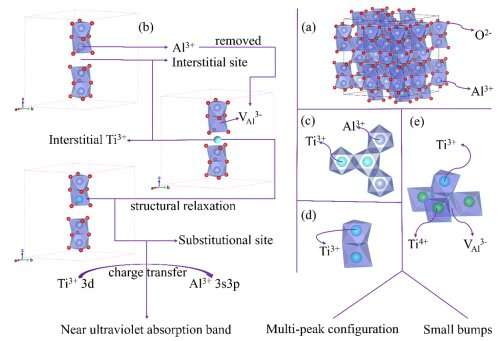Researchers discover origin of near ultraviolet and visible absorption characteristics of Ti: sapphire laser crystals

Recently, a research group from the Shanghai Institute of Optics and Fine Mechanics (SIOM) of the Chinese Academy of Sciences (CAS) carried out a theoretical study on the origin of Ti: sapphire laser crystal in near ultraviolet and visible regions using the first principles method based on density functional theory. Related research results have been published in Materials Today Communications .
Ti: sapphire, also known as Ti-doped α-Al2O3 single crystal, is a very important laser crystal material. At present, it is also one of the key materials in a class of super-intense, ultrafast, and tunable laser devices. Since the laser properties of it was reported in 1982, the origin of some suspicious absorption phenomena in the optical absorption band of Ti: sapphire has been one of the focuses of attention and research.
According to the wavelength distribution, these questionable absorption bands can be roughly divided into three regions: the near ultraviolet absorption band with a peak at 390 nm, the visible absorption band with multi-peak configuration and small bumps, and the residual infrared absorption band overlapped with the laser emission band.
In this study, the researchers performed a systematic theoretical study on the suspicious absorption phenomenon of Ti: sapphire in near ultraviolet and visible regions.
Through the analysis of the crystal structure of alumina and the calculation of the electronic and optical properties of the possible single Ti doping defect models and Ti ion pair defect models in Ti: sapphire, they pointed out that when there is an Al vacancy near the interstitial Ti3+, the interstitial Ti3+ will enter the Al vacancy through structural relaxation, and finally form defect equivalent to the substitutional Ti3+.
The charge transfer transition of substitutional Ti3+ ion's 3d electron from Ti 3d orbital to Al 3s3p orbital is the main reason for the near ultraviolet absorption band, and the calculated absorption spectra are in good agreement with the experimental spectra.
Moreover, the multi-peak configuration and bumps of the visible absorption band are mainly caused by the contribution of the line-contact Ti3+-Ti3+, face-contact Ti3+-Ti3+, and point-contact Ti4+-Ti3+ ion pairs.
In addition, the researchers provided a more comprehensive understanding of the multi-peak configuration and bumps of visible absorption bands from the perspective of ligand field theory and thermal activation.
This study not only reveals the origin of the suspicious absorption characteristics in Ti-doped Al2O3 crystal but also provides ideas for the study of defects and properties of similar transition metal ions doped oxides having corundum structure.
More information: Qiaorui Gong et al, Theoretical study on near UV and visible optical absorption characteristics of Ti-doped α-Al2O3 single crystals, Materials Today Communications (2021). DOI: 10.1016/j.mtcomm.2021.102506
Provided by Chinese Academy of Sciences



















